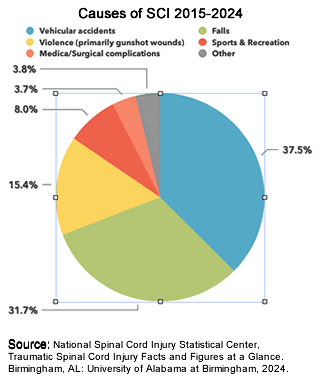Introduction
 Epidemiology
Epidemiology
A Spinal Cord Injury or Disorder (SCI/D) is a life changing condition. The 2024 published, National Spinal Cord Injury Statistical Center (NSCISC) estimate of the annual incidence of SCI in the U.S. to be around 18,000.
The NSCISC ranked causes of spinal cord injury for years 2015 through 2024.
- Vehicular accidents rank 1st in causes of spinal cord injury, accounting for about 37.5% of all reported spinal cord injuries.
- Falls rank 2nd with about 31.7% of spinal cord injuries.
- Violence (primarily gunshots wounds) ranks 3rd with about 15.4% of spinal cord injuries.
- Sports & recreational activities accounted 8.0% of spinal cord injuries and ranks 4th in causes of spinal cord injury.
- Medical/ Surgical complications accounted for about 3.7%
- Other was about 3.8%
Mechanisms of spinal cord injury
- Primary spinal injury
- compression of spinal cord
- traumatic cord disruption
- ischemia, hypoperfusion, thrombosis
- tumor
- Secondary injury (inflammatory effects) that begins almost immeditiately and can remain ongoing for years:
- activation of scar forming macroglial cells
- activation of microglia, the phagocytic immune cells of the CNS that release pro-inflammatory and anti-inflammatory cytokines,
- excitotoxic effects of neurotransmitter release including glutamate
- Glial scar formation, cord tethering, syrinx formation (Sacino, 2019)
Care considerations
Due to the complex nature of the condition and the treatments required, acute SCI/D victims should be stablized and transferred to a neurological care center as soon as possible.
- The specialized care provided by neurological care centers has reduced the average length of stay for SCI patients from 24 days in the 1970s to 11 days recently.
- Rehabilitation lengths of stay have also declined from 98 days in the 1970s to 31 days recently .
- Since 2015, 17% of persons with SCI are employed at year 1 post-injury. The employment rate increases over time to 32% at 30 years post injury
- Re-hospitalization one or more times per year is necessary for about 30% of persons with SCI
- The length of hospital stay for re-hospitalization averages about 19 days.
- Diseases of the genitourinary system are the leading cause of re-hospitalization, followed by disease of the skin. Respiratory, digestive, circulatory, and musculoskeletal diseases are also common causes of re-hospitalization (NSCISC, n.d.).
This course describes:
- The normal anatomy and physiology responsible for micturition, i.e. urination,
- SCI/D disruption of the coordinated communication between the lower urinary tract (LUT) and the higher levels of brain function,
- Practical strategies for minimizing urinary tract dysfunction after SCI , e.g.,
- Upper Tract Complications - vesicoureteral reflux, hydronephrosis, urolithiasis, renal failure, recurrent UTI, sepsis
- Lower Tract complications - recurrent UTIs, bladder cancer, catheter induced injury, urinary incontinence (Wu, S. Y., et al. 2022)
https://www.sci-info-pages.com/spinal-cord-injury-glossary/ is a great SCI web reference glossary.
References
Sacino, A., & Rosenblatt, K. (2019). Early Management of Acute Spinal Cord Injury-Part I: Initial Injury to Surgery. Journal of neuroanaesthesiology and critical care, 6(3), 213–221. https://doi.org/10.1055/s-0039-1694688
Spinal Cord Injury Facts and Figures at a Glance (n.d.). National SCI Statistical Center (NSCISC). https://www.nscisc.uab.edu/
Wang, T. Y., Park, C., Zhang, H., Rahimpour, S., Murphy, K. R., Goodwin, C. R., Karikari, I. O., Than, K. D., Shaffrey, C. I., Foster, N., & Abd-El-Barr, M. M. (2021). Management of Acute Traumatic Spinal Cord Injury: A Review of the Literature. Frontiers in surgery, 8, 698736. https://doi.org/10.3389/fsurg.2021.698736
Wu, S. Y., Jhang, J. F., Liu, H. H., Chen, J. T., Li, J. R., Chiu, B., Chen, S. L., & Kuo, H. C. (2022). Long-Term Surveillance and Management of Urological Complications in Chronic Spinal Cord-Injured Patients. Journal of clinical medicine, 11(24), 7307. https://doi.org/10.3390/jcm11247307
 Epidemiology
Epidemiology Epidemiology
Epidemiology